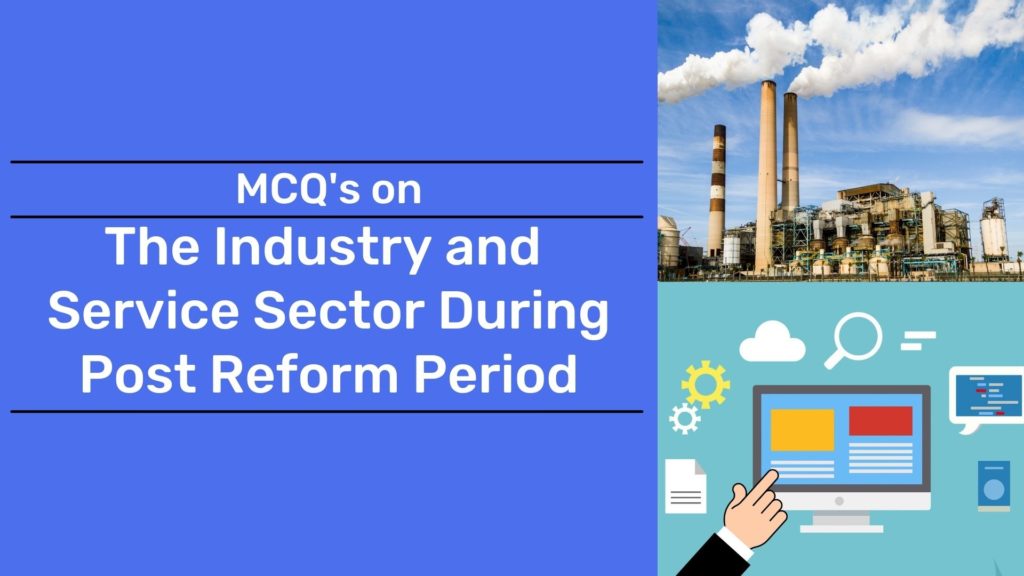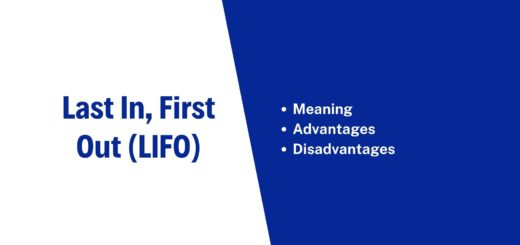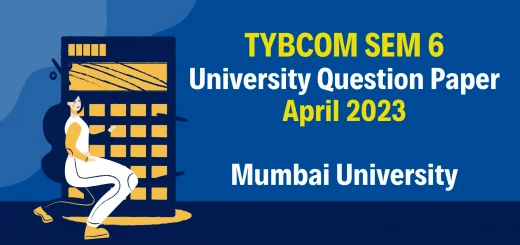The Industry and Service Sector During Post Reform Period MCQ | 60 Free MCQs
The Industry and Service Sector During Post Reform Period MCQ
1. Industrialization involves…………….
a. Technological innovation
b. social changes
c. relative decline of agriculture’s share in the GDP
d. all of these
2. Functional composition of industries refers to……………..
a. Ownership based criteria
b. use based criteria
c. investment based criteria
d. turnover based criteria
3. …………….. is not part of NEP 1991.
a. Increased investment in public sector enterprises
b. abolition of licensing policy
c. encouraging FDI
d. amendment of MRTP Act
4. …………….. is not an objective of the Competition Act 2002.
a. Prohibition of anti-competitive agreements
b. Regulation of combinations
c. control of monopolies
d. prohibition of abuse of dominant position
5. Competition advocacy refers to………….
a. Control of monopolies
b. restricting investments through licensing
c. control of unreasonable profits
d. promoting a competitive culture.
6. …………… is not true for a PSU in India
a. Generated large scale employment
b. high returns on investment
c. saved foreign exchange
d. created a diversified industrial base for India
7. ……………. is a problem faced by PSUs in India.
a. Mounting losses
b. Underutilization of capacity
c. administrative defects
d. all of the above
8. ……………. department of government is responsible for disinvestment.
a. Department of investment and public asset management
b. Department of commerce
c. Department of industrial policy and promotion
d. Department of revenue
9. Offer of shares by a listed CPSE or the government out of its shareholding or a combination of both to the public for subscription is done through………….
a. IPO
b. Offer for sale
c. FPO
d. Strategic sale
10. Only financial institutions can participate in……………
a. IPO
b. Offer for sale
c. FPO
d. Institutional placement programme
| Answers: 1)all of these 2)use-based criteria 3)Increased investment in public sector enterprises 4)control of monopolies 5)promoting a competition culture 6)high returns on investment 7)all of the above 8)Department of investment and public asset management 9)FPO 10)Institutional placement programme |

11. In 1999, the investment limit of small scale unit was determined at…………
a. Rs 25 Cr
b. Rs 50 Cr
c. Rs 1 cr
d. Rs 5 Cr
12. The MSME Act was passed in………….
a. 2005
b. 2002
c. 2008
d. 2006
13. According to MSME Act, micro manufacturing units are classified as those with investment limit of………….
a. Rs 25 lakh
b. Rs 50 lakh
c. Rs 1 Cr
d. Rs 75 lakh
14. …………units in ……………. sector have an investment range between Rs 2 cr and rs 5 cr.
a. Medium, manufacturing
b. micro, manufacturing
c. small, service
d. medium, service
15. A separate ministry for small industries was sept up in……………..
a. 1991
b. 1999
c. 2007
d. 2005
16. ……………. is a nodal development agency for the MSME sector.
a. Divisional Commissioner MSME
b. Development Commissioner MSME
c. Directorate General MSME
d. Development Council MSME
17. …………….. is a SIDBI initiative that provides capital to new SME start ups.
a. ISARC
b. Credit Guarantee Fund Trust
c. CLCSS
d. SIDBI venture capital limited
18. …………. is not a SIDBI initiative.
a. ICRA
b. SMERA
c. CGFT
d. ISARC
19. MSME-MDA does not provide funding to MSMEs for……………..
a. Participation in international trade fairs
b. Acquiring quality and environmental certifications.
c. carrying out sector specific market studies
d. contesting anti-dumping cases
20. The scheme to improve ease of doing business in the MSME sector is……………
a. SFURTI
b. UAM
c. CLCSS
d. ASPIRE
| Answers: 11)Rs 1 cr 12)2006 13)Rs 25 lakh 14)medium, service 15)1999 16) Development commissioner MSME 17)SIDBI venture capital limited 18)ICRA 19)Acquiring quality and environmental certifications 20)UAM |
21. …………… by and large labour intensive.
a. MSMEs
b. Large scale
c. both of these
d. none of these
22. The law enacted as an outcome of the Bhopal Gas tragedy is…………….
a. Public liability insurance Act
b. The environment (protection) Act
c. The Air Control of pollution Act
d. All of these
23. ………….. is not true of toxic wastes in India.
a. There are highly efficient systems for their disposal
b. they can be caused by e-waste
c. handling them can be fatal at times
d. these constitute 10 to 15 % of industrial wastes
24. Air pollution is caused by…………..
a. Release of harmful gases
b. solid and liquid particulate matter
c. smoke emission
d. all of the above
25. ……….. is not true about global warming.
a. It is causing glaciers to melt
b. it has put human lives to threat
c. it has prevented extinction of wildlife
d. it has resulted in frequent natural calamities.
26. …………… activity does not belong to service sector.
a. Retail trade
b. real estate
c. insurance
d. automobile
27. In 2019-20, the service sector’s contribution to GVA was……………
a. 55.3%
b. 65.2%
c. 59%
d. 45%
28. The services sector’s contribution to employment as percentage of total employment , in 2018 was………………
a. 40%
b. 31.54%
c. 50.5%
d. 25%
29. The FDI limit in multi-brand retailing is……………
a. 49%
b. 74%
c. 100%
d. 51%
30. The FDI limit in single-brand retailing is……………..
a. 49%
b. 74%
c. 100%
d. 51%
| Answer: 21)MSMEs 22)The environment (protection) Act 23)There are highly efficient systems for their disposal 24)all of the above 25)it has prevented extinction of wildlife 26)automobile 27)55.3% 28)31.54% 29)51% 30)100% |
31. The health care industry includes…………..
a. Hospitals
b. health insurance
c. pharmaceutical companies
d. all of the above
32. FDI limit permitted for healthcare related services under automatic route is…………….
a. 49%
b. 74%
c. 100%
d. 51%
33. …………. has growth potential in the healthcare industry in India
a. Growing Insurance market
b. expanding medical tourism
c. telemedicine
d. all of the above
34. The Competition Act for promoting competition in market was implemented in the year………….
a. 1969
b. 2003
c. 2002
d. 1991
35. Competition Amendment bill was introduced in the year …………
a. 2003
b. 2007
c. 2000
d. 2002
36. The full form of MRTP Act is …………
a. Monopolies and Restrictive trade practices act
b. Monopolies and Regulatory trade practices act
c. Mergers and Restrictive trade practices act
d. Monopolies and Resolution trade practices act
37. Under the competition Act 2002 the unfair Trade Practices of companies were referred to …………
a. CCI
b. MRTPC
c. NITI AAYOG
d. Consumer’s court
38. The competition Act 2002 was introduced by …………
a. S.V.S. Raghavan
b. G.K. Ramakrishnan
c. R.H. Patil
d. Krishnamurthy
39. The board for the reconstruction of PSEs was constituted in the year ………….
a. April 1991
b. August 1998
c. December 2004
d. April 1993
40. ………….is a limitation of the disinvestment policy in India.
a. Problem of finding a strategic partner
b. reduction in employment
c. hasty procedure
d. all of the above
| Answer: 31)all of the above 32)100% 33) All of the above 34)2002 35)2000 36)Monopolies and Restrictive Trade Practices Act 37) CCI 38)S.V.S. Raghavan 39)December 2004 40)all of the above |
41. A form of pollution due to industrial practice is known ……………….. as pollution.
a. Industrial
b. agriculture
c. both of these
d. none of these
42. …………….. pollution is caused by deposit of organic and inorganic industrial waste into river .
a. Thermal
b. water
c. air
d. all of these
43. …………….. pollution is the result of hot water percolating from industries into rivers before cooling.
a. Water
b. thermal
c. air
d. none of these
44. …………… sector is the driver of economic growth in India.
a. Industrial
b. services
c. Agriculture
d. all of these
45. With economic prosperity the demand for …………… rises faster.
a. Primary goods
b. secondary goods
c. services
d. manufacturing goods
46. …………… has the responsibility of protecting the interest of the insurance policy holder.
a. RBI
b. Commercial banks
c. IRDA
d. all of these
47. Insurance density is …………… in India.
a. Constant
b. rising
c. falling
d. irregular
48. A rising percentage of FDI contribution to services sector is seen among ……………..
a. Media
b. real estate
c. tourism
d. infrastructure
49. ……………… tourism is experiencing marked growth in India in recent years.
a. Heritage
b. eco
c. medical
d. adventure
50. Services sector is also known as ………………
a. Primary sector
b. secondary sector
c. tertiary sector
d. all of the above
| Answer: 41)Industrial 42)water 43)thermal 44)service 45)services 46)IRDA 47)rising 48)tourism 49)medical 50)tertiary sector |
51. The health care industry is expected to grow at ……………. CAGR during 2008-2020
a. 16.5%
b. 10%
c. 12 %
d. None of these
52. The ……………. logo is used to promote tourism in India.
a. Make in India
b. Investment in India
c. Incredible India
d. None of these
53. The national Tourism policy was initiated in the year ………………. .
a. 1991
b. 2002
c. 2000
d. 2012
54. ……………. is a primary health care Centre.
a. AYUSH
b. Incredible India
c. LaQshya
d. none of these
55. The service economy in developing countries is mostly concentrated in ………………. .
a. Financial services
b. hospitality
c. retail
d. all the above
56. Tourism policy highlights ………….
a. Swagat (welcome)
b. Soochna (information)
c. Suvidha (Facilitation)
d. All the above
57. Competition Act is not applicable in following cases …………….
a. Public financial institutions
b. FIIs
c. banks
d. All the above
58. MSME s means …………..
a. Micro, Small and Medium enterprises
b. Mini, Small and Medium enterprises
c. Micro, Small and Medium employment
d. none of the above.
| Answer: 51)16.5% 52)Incredible India 53)2002 54)AYUSH 55)all the above 56)All the above 57)All the above 58)Micro, Small and Medium enterprises |
Learn the chapters on TYBCOM from our YouTube channel.


